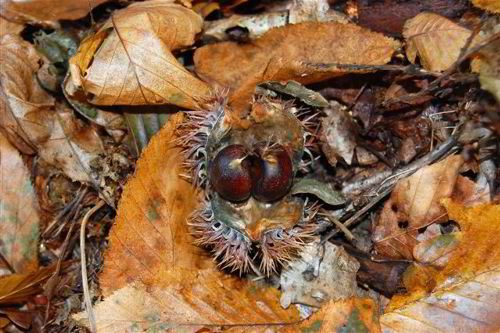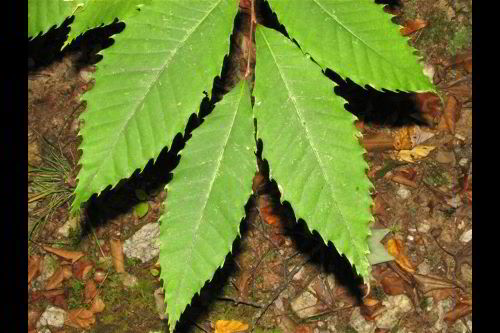|
==============================================================================
TOPIC: Chestnuts in Big Ivy
http://groups.google.com/group/entstrees/browse_thread/thread/b828ac4d1ace5abb?hl=en
==============================================================================
== 1 of 2 ==
Date: Sun, Oct 19 2008 4:33 pm
From: James Parton
ENTS,
Yesterday, Joy and I went back to the Big Ivy ( Coleman Boundary )
area to check the chestnut trees at the Corner Rock picnic area (
Dillingham Rd ) for viable chestnuts. As I have stated in past
reports I am unsure of the identity of these trees in whether they
are pure American or an American+Chinese hybrid. I found viable
fully formed chestnuts on the ground.
 Joy with American chestnut
Joy with American chestnut
They are small in size like
the American tree and are sweeter in taste than any Asian chestnut I
have tried. They are the best chestnuts I have eaten with the
exception of the Chinquapin. Later in the evening I stopped by some
Chinese chestnuts that I knew of on Sugerloaf Rd ( Hendersonville )
and collected some nuts for comparison. They are nearly three times
bigger than the Dillingham trees.
 Dillingham nuts
Dillingham nuts
 Dillingham leaves
Dillingham leaves
The Dillingham trees have nuts
larger than Chinquapins but smaller than Asian chestnuts. This
matches the American trees closely. If these two trees are indeed
hybrids their traits more closely match their
American relative. The only thing that leads me to thinking they are
hybrids are a slightly different shape to the leaf. Not dramatic. I
thank Bob Anders and Walt Christian for letting me know of these
trees.
 Typical chestnut leaves
Typical chestnut leaves
After collecting nuts from the Corner Rock chestnuts we rode up to
the trailhead to Douglas Falls. Earlier in the year Will Blozan told
me of a 60ft tree he had seen in there that was right on the trail
and I hoped to locate it. We found it and one other decent sized one
nearby. Will's tree was measured using laser/clinometer to be 58.85
feet tall. The other one was a respectable 41.16 feet tall. I found
a couple of others that were around 20 feet tall. I hope to do a
more detailed exploration of the area in the future.

The fall colors are beautiful. . By the way, the hemlocks seem even worse than they were back during
the summer. It does not look good for them.
American Chestnut 41' 16Ft
1Ft 3In CBH
American Chestnut 58' 85Ft
2ft 2In CBH
http://www.nativetreesociety.org/fieldtrips/north_carolina/bigivy/big_ivy_chestnuts_nc.htm

To add, On the picture with the chestnuts on the table the
left ones
are Chinese and the smaller ones on the right are the ones from the
Dillingham ( American? ) tree. Google omitted part of the pictures
file name.
James P.
==============================================================================
TOPIC: Chestnuts in Big Ivy
http://groups.google.com/group/entstrees/browse_thread/thread/b828ac4d1ace5abb?hl=en
==============================================================================
== 1 of 2 ==
Date: Wed, Oct 22 2008 3:30 pm
From: Matthew Hannum
Very interesting! Good to see some American Chestnuts, or close
cousins of them, still living in the wild. Viable nuts - that's
quite
a find, too! I've never seen an American Chestnut tree in fruit.
Were
there any signs of the Blight in the area?
I wonder how many natural hybrids between American Chestnut and
Chinese Chestnut have happened in the wild? This type of natural
crossbreeding may be one of few ways for the Chestnut to continue in
the wild since only Blight resistant trees probably live long enough
to set fruit. Of course, it would probably take forever for a
natural
hybrid cousin to the American Chestnut with Blight resistance to
spread through the forests.
Anyway, good finds!
== 2 of 2 ==
Date: Wed, Oct 22 2008 4:42 pm
From: James Parton
Matthew,
I don't think Chinese-American hybrids are that common in the wild
but
I know some of them exist. The Dillingham trees may be two of them.
Chinknut ( An American Chestnut Chinquapin cross ) is more common.
Yes, the blight is there. These trees have some dead limbs that are
almost surely blight caused but the trees are otherwise quite
healthy.
The American Chestnuts on the Douglas falls trial also show some
evidence of the blight but still appear quite healthy. I have found
burrs on quite a number of Am Chestnut trees, but sadly all but the
Dillingham trees have tiny atrophied nuts. I would have liked to
have
made it back to Mt. Jefferson to have seen if it had viable nuts. It
is a nice well formed tree.
I dream of a 100ft chestnut with viable nuts!!
James Parton
==============================================================================
TOPIC: Chestnuts in Big Ivy
http://groups.google.com/group/entstrees/t/b828ac4d1ace5abb?hl=en
==============================================================================
== 1 of 3 ==
Date: Wed, Nov 12 2008 5:34 pm
From: Randy Brown
James,
I have an Asian and Pure America chestnut trees on my property that
finally both bore nuts this year (after 15 years!). I took pictures
of them this fall for a comparison. Asian on the left, American on
the right:


In comparison the Dillingham burrs look pretty asian:
The asian spines are hard, stiff and needlike and will stick you
painfully if you push on them. The american in contrast are quite
fine and will bend with out sticking(too much) if you push on
them.
Kind of like prickly fur.
== 2 of 3 ==
Date: Thurs, Nov 13 2008 1:20 am
From: James Parton
Randy,
I have suspected since I first saw the Dillingham trees that they
were
not a pure native chestnut. It is notable, especially in the leaves.
Like you, I have noticed that the burrs on Asian trees are courser
than the American ones. Another difference is the American Chestnuts
are somewhat smaller than their Asian cousins.
Thanks for helping me id the Dillingham trees. I have been
scratching
my head on their exact id for awhile. While I don't think they are
pure Asian, they have some Asian characteristics. Some in the leaf
and
as you have confirmed, in the burrs. The nut itself is more American
in size. The leaf also is thin and hairless like the American though
it has a shape a bit like the Asian types. My conclusion, a hybrid.
They are some introduced trees ( Norway Spruce and White Cedar ) in
a
field nearby and I think the forest service may have planted them
years ago at the fields edge and the forest has overtook them. Years
back before TACF started experimenting with the backcross method
many
people planted Chinese+American hybrids. These ( Dillingham ) trees
are pretty big and have been here for some time. Incidentally the
growth form of the Dillingham trees are a bit different than most of
the Americans I have seen. Americans are tall and straight. These
are
a bit more bushed out. Russ mentioned that to me in a post awhile
back.
James P.
== 3 of 3 ==
Date: Thurs, Nov 13 2008 1:27 am
From: James Parton
Randy,
Many hybrids are still available. A notable one is the Dunstan
Chestnut.
http://www.chestnuthilltreefarm.com/Chestnuts.html
James Parton.
|